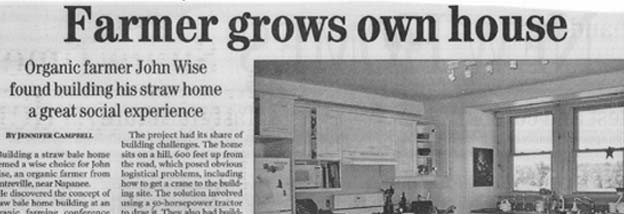Farmer Grows Own House – Ottawa Citizen
By Jennifer Campbell
Building a straw bale home seemed a wise choice for John Wise, an organic farmer from Centreville, near Napanee.
He discovered the concept of straw bale home building at an organic farming conference he’d attended a few years earlier. So, when the time came for he and his “sweetie” Anita Janssman to move in together, they decided to give it a try. They located Canada’s straw bale experts — Peter Mack and Chris Magwood (authors of Straw Bale Building) — who were just a “stone’s throw away” in Guelph and went to work.
“I phoned them in January of 2000 and they agreed to squeeze us in that summer,” he says. “We started the process in June and moved in in December.”
They moved into their home, a beautiful, original construction complete with a tall, classic-looking tower on the front, within about six months of starting the job. And because he’s an organic farmer, he was able to bale the hay himself.
The project had its share of building challenges. The home sits on a hill, 600 feet up from the road, which posed obvious logistical problems, including how to get a crane to the building site. The solution involved using a
50-horsepower tractor to drag it. They also had building permit delays because straw bale doesn’t fit into conventional building codes so the engineer must give it its stamp of approval.
“We did have a number of little crises to overcome,” Mr. Wise says, laughing.
In the end, however, they’re glad they went the straw bale route.
“We thought it was a nice way to save a few trees and get a super-insulated home,” he says.
Still, after his first winter in the house, he can’t be sure he saved on heating. For one thing, his heating system wasn’t entirely finished. Eventually, he will complement his propane with a wood stove and solar panels, but only the propane was in operation over the winter of 2000-2001.
“The cost of propane skyrocketed this winter so it was hard to tell if we saved,” he says, adding that he hasn’t done the math to see how much they used.
In the summer, he says, it does stay cooler inside. If it’s 29C outside, it will likely be 22C inside though it will warm up after several consecutive stifling days.
While Mr. Wise says the straw bale option didn’t turn out to be any cheaper, it wasn’t any more expensive and they do hope to save in heating costs in the long run.
One big advantage, he says, was the culture of straw bale building.
“It was a riot. These people — Peter and Chris and Ben Polley — were so much fun to work with. Some of the crew were musicians and so am I so there would be jam sessions around the campfire at night.
“As a farmer, my job is quite solitary,” he says. “So this was a great social experience. I’d recommend it to people who want to be involved in the building process.”

